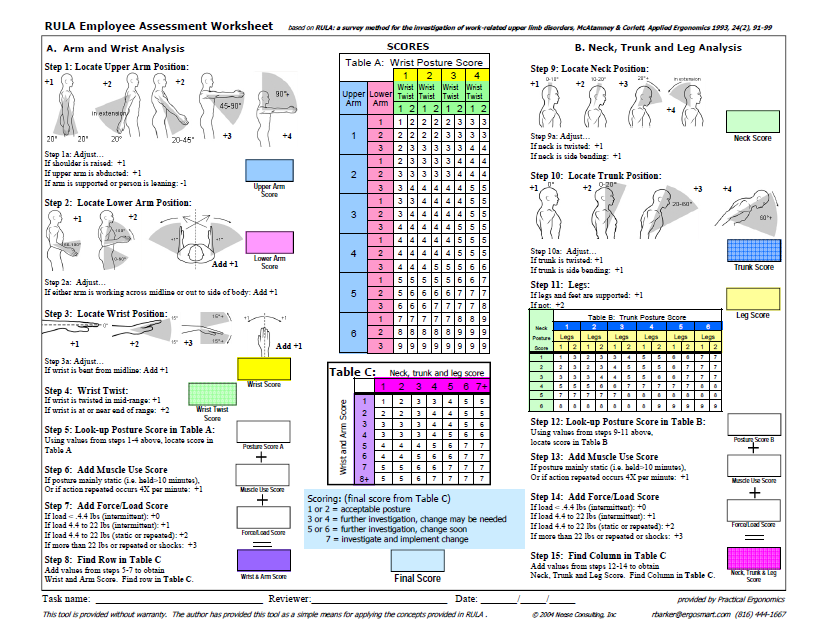Rapid Upper Limb Assessment (RULA): Difference between revisions
No edit summary |
Kim Jackson (talk | contribs) m (Text replacement - "Category:Assessment and Examination - Wrist" to "Category:Wrist - Assessment and Examination") |
||
| (9 intermediate revisions by 3 users not shown) | |||
| Line 5: | Line 5: | ||
</div> | </div> | ||
== Objective | == Objective == | ||
Developed by Mc Atamney in 2005 as a survey method for use in ergonomics investigations of workplaces where work related upper limb disorders are reported. | Developed by Mc Atamney in 2005 as a survey method for use in ergonomics investigations of workplaces where work related upper limb disorders are reported. | ||
| Line 12: | Line 12: | ||
== Intended Population | == Intended Population == | ||
Survey of workplaces where work related upper limb disorders are reported. | Survey of workplaces where work related upper limb disorders are reported. | ||
| Line 25: | Line 25: | ||
[[Image:RULA.png|center]] | [[Image:RULA.png|center]] | ||
=== Reliability === | === Reliability === | ||
| Line 32: | Line 30: | ||
RULA demonstrated higher intra-rater reliability than inter-rater reliability although both were moderate to good. RULA was more reliable when used for assessing the older children (8-12 years) than with the younger children (4-7 years). RULA may prove useful as part of an ergonomic assessment, but its level of reliability warrants caution for its sole use when assessing children, and in particular, younger children. | RULA demonstrated higher intra-rater reliability than inter-rater reliability although both were moderate to good. RULA was more reliable when used for assessing the older children (8-12 years) than with the younger children (4-7 years). RULA may prove useful as part of an ergonomic assessment, but its level of reliability warrants caution for its sole use when assessing children, and in particular, younger children. | ||
== References == | == References == | ||
<references /> | <references /> | ||
[[Category:Occupational Health]] | |||
[[Category:Cervical Spine]] | |||
[[Category:Shoulder]] | |||
[[Category:Elbow]] | |||
[[Category:Wrist]] | |||
[[Category:Hand]] | |||
[[Category:Assessment]] | |||
[[Category:Cervical Spine - Assessment and Examination]] | |||
[[Category:Shoulder - Assessment and Examination]] | |||
[[Category:Elbow - Assessment and Examination]] | |||
[[Category:Wrist - Assessment and Examination]] | |||
[[Category:Hand - Assessment and Examination]] | |||
Latest revision as of 23:00, 29 August 2019
Original Editor - Ajay Upadhyay
Top Contributors - Kim Jackson, Ajay Upadhyay, WikiSysop and Amrita Patro
Objective[edit | edit source]
Developed by Mc Atamney in 2005 as a survey method for use in ergonomics investigations of workplaces where work related upper limb disorders are reported.
It is aimed to make a rapid assessment on neck and upper limb loading in mainly sedentary tasks.
Intended Population[edit | edit source]
Survey of workplaces where work related upper limb disorders are reported.
Method of Use[edit | edit source]
Positions of individual body segments will be observed and the more there is deviation from the neutral posture the higher will be the score of each body part.
The risk is calculated into a score of 1 (low) to 7 (high).
Categorization of body postures and force, with action levels for assessment
Reliability[edit | edit source]
RULA demonstrated higher intra-rater reliability than inter-rater reliability although both were moderate to good. RULA was more reliable when used for assessing the older children (8-12 years) than with the younger children (4-7 years). RULA may prove useful as part of an ergonomic assessment, but its level of reliability warrants caution for its sole use when assessing children, and in particular, younger children.







